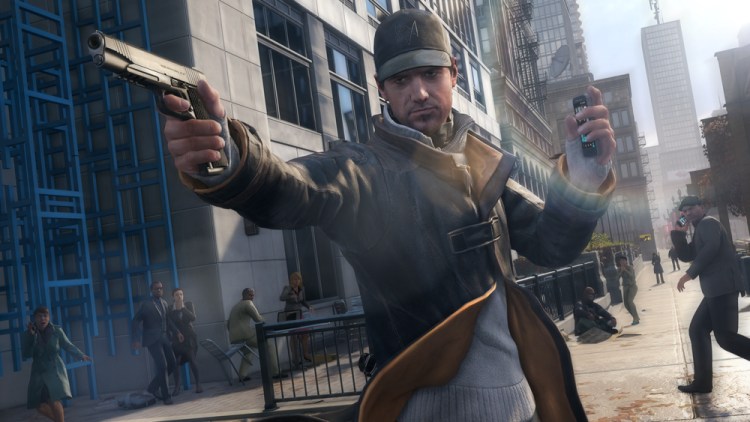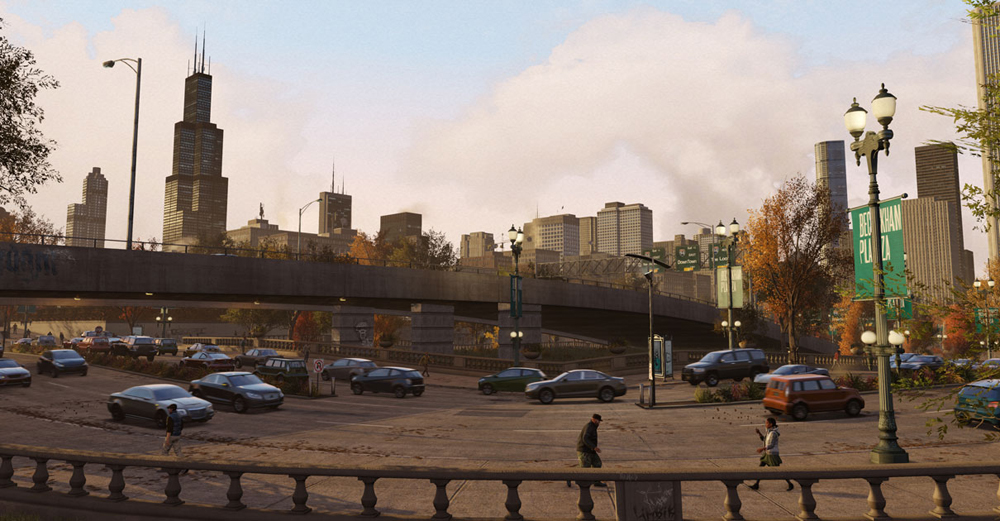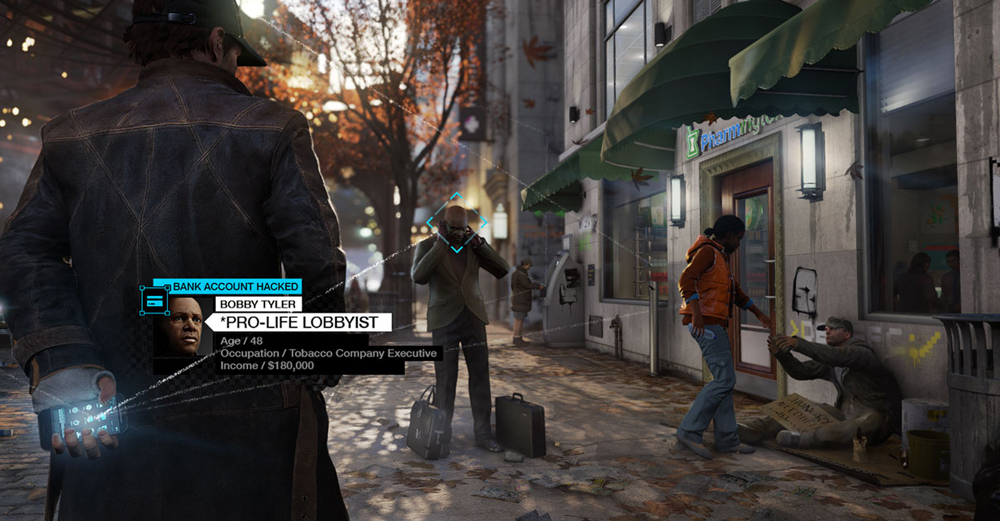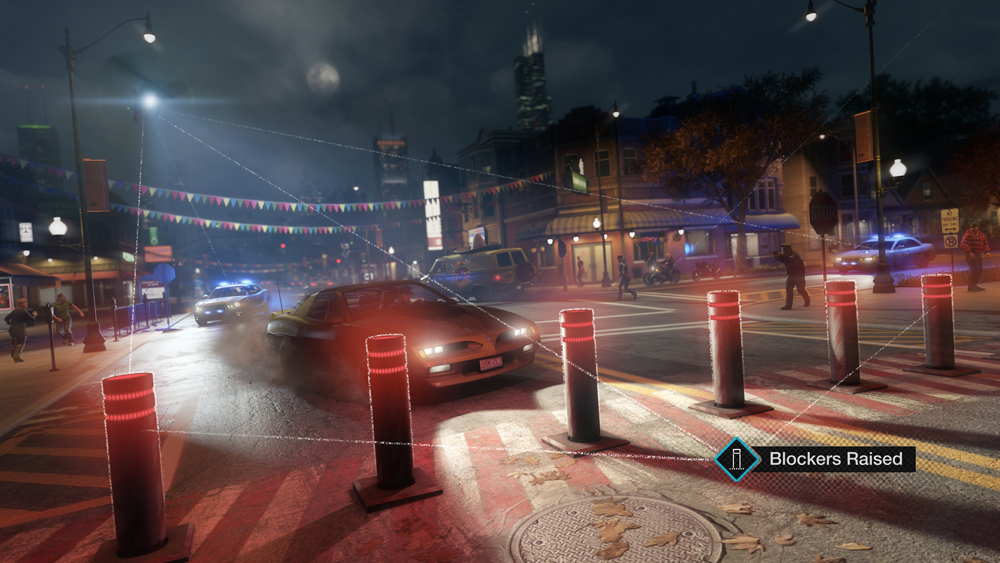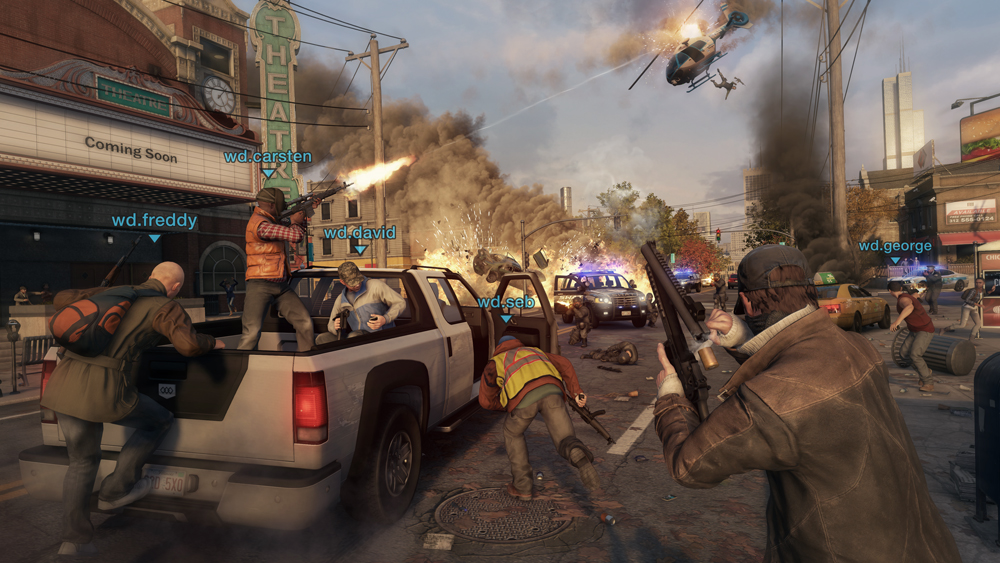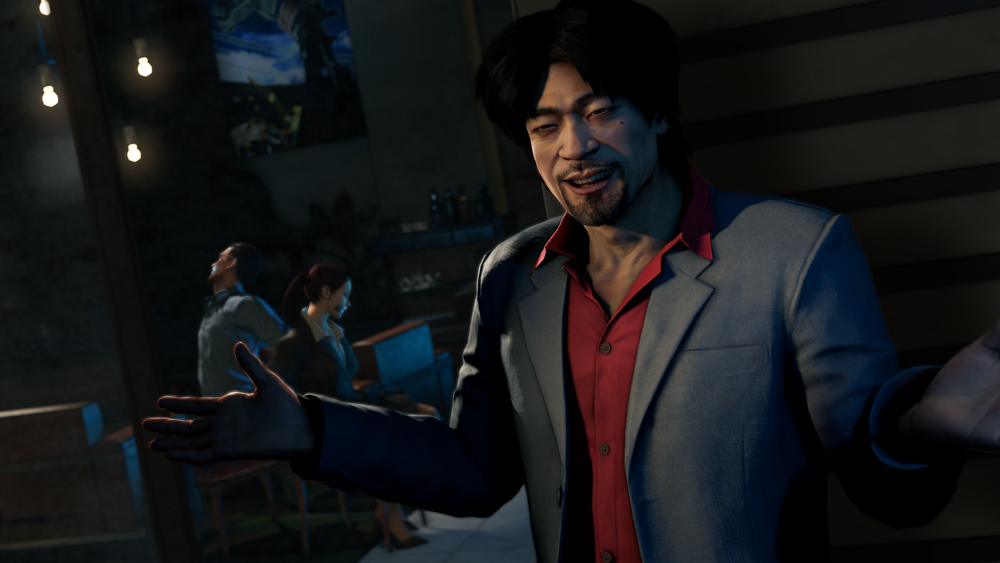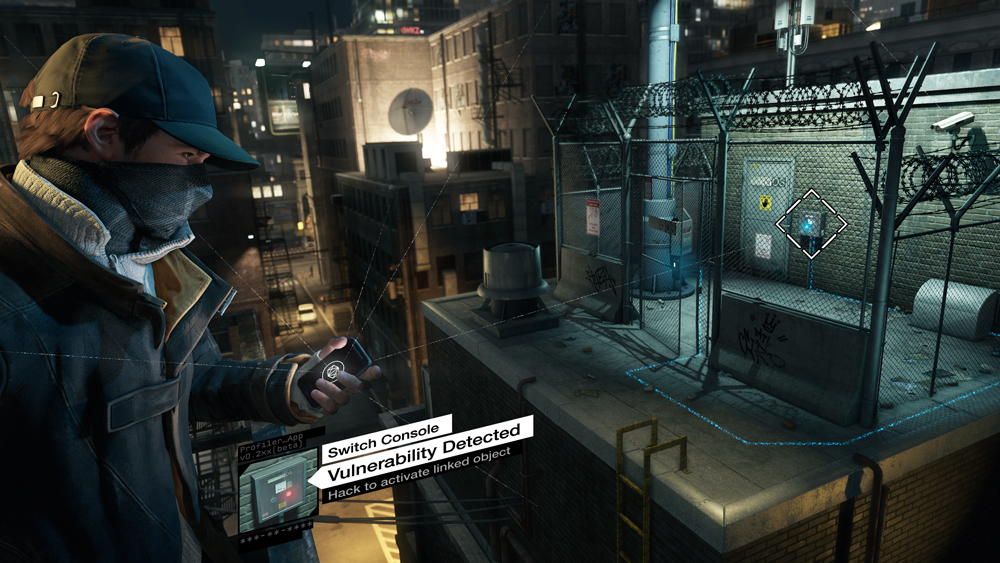Check out our Reviews Vault for past game reviews.
I am the omniscient god-king of Chicago. I monitor my citizen-subjects through a thousand unblinking eyes and sit atop a digital throne. When I crave amusement, I peruse their mundane factoids, their terrible secrets and vile perversions. When I require tribute, it is immediate and plentiful. When I demand excitement, the city tears itself open in a million ways all around me. This city belongs to me. And if you inhabit this superconnected, near-future Chicago, you belong to me, too.
Everyone walking these streets knows my name, but few know my face. Such is the role of vigilante Aiden Pearce in Ubisoft Montreal’s Watch Dogs. Ubisoft’s first open-world game designed and purposed specifically for the PlayStation 4/Xbox One generation of hardware, Watch Dogs has towered on the horizon as one of the first true peaks of the new era. And after five years in development, Ubisoft’s newly minted franchise does indeed deliver a dense and potent world built on a foundation of excellent systems despite inconsistencies and a mostly vacant protagonist.
What You’ll Like
A city like no other
If you’ve ever been to Chicago, you’ll appreciate the craftsmanship that has obviously gone into capturing not just much of the city’s geography but its culture and vibe as well. While not a completely accurate rendition — which admittedly wasn’t Watch Dogs’ goal — the city on display is both a design and artistic accomplishment. While many open-world offerings pack impressive square footage, very few instill that lived-in feeling that — if done correctly — isn’t even noticeable until it’s suddenly missing. Over many days of wandering through Chicago’s moody, trash-covered alleyways and glistening office buildings, everything appeared placed with purpose.
The transformation of Watch Dogs’ Chicago from detailed backdrop to interactive playground is the work of ctOS, city-wide software that connects every electronic facet of the city’s infrastructure. By exploiting vulnerabilities in the system, you’re free to hack hundreds of cameras scanning the city; manipulate bridges, traffic lights, and public transit; trip transformers, burst steam pipes, and generally have your way with anything that ctOS system touches. You’ll always find something to interact with in every district of Chicago and its outlying neighborhoods. In Watch Dogs, the city is by far the most reliable and engaging character.
Thanks to the terrifying facial-recognition component of ctOS, extracting information from citizens in eyeshot is as simple as whipping out your phone and peering into their stored profiles. The bulk of Chicago’s thousands of inhabitants roaming the streets are procedurally generated, piecing together faces with names and ages, assigning them occupations, salaries, habits and tendencies from a data bank so extensive that duplicates are rare. Though inconsistencies occasionally arise — like the face of an elderly man paired with the profile of a 22-year-old window washer — the system generates a city’s-worth of varied people that continued to surprise me with new quirks and interactions even after I thought I’d seen them all.
Mayhem, madness, and missions
Of course, a mammoth urban jungle is only as engaging as there are ways to interact with it. Watch Dogs understands that need and responds in force. Chicago is dense and fully loaded with dozens of activities to keep you busy above and beyond the hefty 20 hour-long story. And while completely new types of missions unlock as you reach key moments of the plot — investigations revolving the seedier elements of the story — it has enough to do right out early on that you could spend hours completing objectives before ever returning to story missions.
Chicago’s neighborhoods are stocked with street hustlers running the shell game, slot machines, and poker games to scratch that gambling itch. If puzzles are more your speed, chess games and challenges dot the city. Additionally, VR code puzzles plaster buildings, and you must view these from a specific camera angle to complete them. And timed puzzles that require creative city navigation are plentiful.
If you’re looking for silly, special graffiti tags trigger alternate-reality games that enable you to blast digital aliens toward a high score or freerun through the streets collecting digital coins. Take your pursuit of recreation a step further and score a digital trip from a shady dealer in a back alley, which are induced hallucinations triggering wild minigames. These digital trips feel like experimental side content that didn’t quite fit the overall scheme. If that’s the case, Ubisoft wisely found a way to work them in because whether you’re mowing down demons in a hell-spawned sedan, bouncing between giant flowers, or annihilating the city in an arachnid tank — which is easily one of my favorite minigames in recent memory — these are over-the-top distractions, and I wish there were more of them.
The serious side of supplementary content comes in the form of side missions and fixer contracts. Fixers are those gifted individuals that have a knack for making problems go away. These are good for a little extra cash and something to do, and I ultimately found fixer contracts and side missions too closely mirrored the same basic mechanics of the story missions — driving, hacking, and gunplay — and tended to drift away from them as fatigue set in.
Your skills matter right from the start
If one thing’s waiting for you to wrench it from the content-crammed streets of Chicago, it’s power. Watch Dogs is chock-full of progression from the very beginning of play until long after the credits roll. In standard fashion, Watch Dogs awards experience and skill points that propel you through 50 levels. Its varied skill tree consists of four main branches: hacking, combat, driving, and crafting items. And within the first tier of skills, major advances in both power and utility are available, adding game-changing effects from the get-go.
Sinking one skill point into the driving branch bestows the ability to remotely unlock cars with the all-purpose smartphone, so you’ll never again have to smash through a window. Watch Dogs’ almost always gives you a new form of interaction with the city proper for spending a skill point. This is most obvious in the hacking tree, which opens up completely new elements of Chicago’s infrastructure to activate on the fly, enabling you approach obstacles in creative new ways.
Though the combat tree tweaks the gun-handling mechanics in your favor, repeated trips to that well offer life-saving takedowns on armored opponents alongside the Focus — the obligatory bullet-time in Watch Dogs. It’s a wholly rewarding system that has tangible benefits and ensures progression remains mostly fun and exciting all the way through, rather than a statistical grind to the top of the power index.
Unlockable rewards for hitting milestones along the story and side missions are also everywhere. Completing Criminal Convoy missions unbolts the Destroyer sniper rifle, while checking off multiple Privacy Invasions enables you to order the Sunrim sports car. Every branch carries specialized rewards so side content isn’t just filler; you’re always working toward something in Watch Dogs so time rarely feels wasted.
A digital turf war
Watch Dogs’ seamless multiplayer experience has received a great deal of attention. While it isn’t as invasive as unknowingly being ambushed by an enemy fixer, this does adds another layer of potential challenge. Players may hack into your world, attempting to steal valuable intel before escaping the scene. These moments are tense, as time is limited and you’re given only a general area in which to search for a disguised player that could look like any randomly generated citizen. It’s a fun game of cat-and-mouse that I found more often than not ends at the barrel of a grenade launcher.
Outside of the invasion mechanic, Watch Dogs’ multiplayer includes a number of modes showcasing a bit of everything it offers. Online races highlight the arcade vehicle handling with the city’s hackable infrastructure as a twist. Online Decryption will likely be the multiplayer purist’s mode of choice. Teams attempt to snag and keep a file in high-speed chases or fortified last stands. The intelligently designed kicker is that you don’t actually need to kill the file-carrying player; simply being in proximity is enough to trigger the download, keeping the action moving and intense.
While a benign online Free Roam is also there, the marquee multiplayer event is the ctOS companion app that’s a free download for both Android and iOS tablets and smartphones. The mobile player can control the many facets of ctOS to block, impede, and ultimately bring their target’s car to a crashing halt while the driver kicks the ignition and attempts slip out of sight.
Multiplayer interactions, including the ctOS companion app, were crisp and responsive with little noticeable lag; however, the review was conducted in a closed environment, and launch-day experiences could differ.
By performing well in or winning online matches, players also earn notoriety points that unlock online-specific skills at specific increments. Abilities like an extended car boost, better financial rewards for victories, and eventually being able to see an image of an invading player’s disguise can all be had with enough notoriety points. Best of all, the unlockable multiplayer skills also carry over to the offline portion of Watch Dogs, ensuring that the multiplayer component also carries weight for solitary types.
What You Won’t Like
An uneven tale
While Watch Dogs is strong in the core mechanics and content it offers, its bloated tale of revenge and redemption is by far its weakest point. Watch Dogs’ central figure, Aiden Pearce, is a checklist of antihero personality traits that never congeals into a relatable protagonist. He straddles the line between soulful family man and unapologetic vessel of selfish destruction, never committing to one side or the other for long. We’re never given an inkling as to what he’ll do next, which is fitting, I suppose, because it genuinely appears as if Aiden Pearce doesn’t know what he’s going to do next until a secondary character appears to refocus him.
The supporting characters themselves are mostly well delivered considering they all fit neatly into a prescribed archetype: the comrade, the villain, the love interest, the dependent, the comic relief. Aiden Pearce relies on them all to fill out the story, and it’s just a shame these characters are clearly there to flesh out aspects of our hero rather than challenge him. One character shows up for a single mission before disappearing completely.
Though his story begins in pursuit of those responsible for an admittedly heartbreaking loss to him and his family, it detours through a dozen subplots that feel more like busy work. After seeing the things that Aiden is capable of, the resources at his disposal, the lengths he’ll go to get what he wants, it can be hard to swallow the that he isn’t capable of resolving his own problems without first being a pawn in everyone’s own agenda.
Fortunately toward the end, things pick back up and long-awaited resolutions finally start to materialize. Again, it’s a shame the pace adopted in the last quarter of the story — which is still a considerable chunk of content, considering the overall runtime — wasn’t there to keep the story moving all the way through. Watch Dogs’ narrative isn’t bad, and its characters aren’t bad; they’re just not particularly compelling after a few hours, and they don’t return to form until several hours before the credits.
Scraping the bottom of humanity’s barrel
I can’t recall the exact moment when I gave up on the people of near-future Chicago. It may have been as I watched Jaden Harrison — a 22-year-old drug dealer — take aggressive sexual advantage of Grace Hsu — a 21-year-old human-trafficking victim — through the unflinching feed of a security camera. It may have been when I hacked into the phone of Joseph Martinez — a twentysomething marketing team leader — as he exchanged text messages wanting someone to know he loved them “before I do what I’m about to do.” Joseph had multiple painkiller prescriptions.
You might think unrestricted access to the most intimate aspects of humanity would be liberating: It’s not. It’s a burden knowing unimpeachably “good people” are as much a half-truth as this dystopian cyberfuture. Credit goes to Watch Dogs for ingesting a player who so inherently identifies with the role of the savior and spitting out a cynical, jaded predator. Though the majority of the citizens are upstanding everyday people, they eventually become pockets of fresh air in a potent, noxious cloud of secrets, fetishes, and perversions. Spending so much time in those fumes saturated my view to the point where everyone became contaminated and the only thing that deserved saving was the city itself from the people crawling all over it.
Whether the intent was to drive home the fear of privacy-invasion showing people for what they really are or as commentary on a morally ambiguous near-future, I don’t know, but the heavy-handedness with which many citizens reveal how disgusting they are is off-putting at times. This increases when hacking into people’s personal electronics: You’ll see video footage of suggested cannibalism; a middle-age man furiously masturbating while his infant cries offscreen; or an elderly woman peering at her neighbors whispering to herself, “Can’t wait for some crackheads to slit your throat and rape your corpse.” It’s shocking and needless and even comical more often than not, and I found myself avoiding hacking certain “interactables” to avoid the tiresome sensational portrayals.
Hacking isn’t our weapon. A weapon is our weapon
Though Watch Dogs heavily emphasizes hacking — going so far as to declare in promotional material that “Hacking is our weapon” — much of it boils down to familiar gunplay mechanics. While it’s true hacking plays an unavoidable, intricate, and welcome part of the experience, our main character can also hoist an impossible two-dozen firearms and enough ammunition to fuel them all.
Many elements of the story and side missions are reminiscent of Ubisoft’s Far Cry 3, where you can approach enemy compounds in a variety of unique ways. While these moments in Watch Dogs offer a similar degree of creativity and can usually be completed with creative hacking and stealth, gunplay is almost always the easier and more efficient alternative. In fact, through much of the campaign, I rarely relied on more than a silenced pistol and the old cover-based exploit of lining up my targeting reticule before popping out of cover to deliver a clean, quiet headshot.
You can negotiate most of Watch Dogs at the end of a barrel, and when you’re holding 30 military-grade firearms on top of an impressive assortment of craftable and explosive solutions, there isn’t really a need to approach things with clandestine future tech. I would have liked to see Watch Dogs rely more heavily on hacking as a requirement for combat, not just puzzle elements.
Conclusion
Though the new-generation moniker may be cliché, it rings true in the dense and beautiful presentation of Watch Dogs. Most of the many, many systems on display have been sharpened to a fine point despite a few that fail to reach their full potential. While minor bugs, inconsistencies, and a lackluster story restrain Watch Dogs, its impressive environments, fluid interconnected mechanics and welcome multiplayer components set the bar for future open-world experiences, and help it to stand as a sign of things to come.
Score: 85/100
Watch Dogs is out now for PlayStation 4, Xbox One, PlayStation 3, Xbox 360, and PC. The publisher invited GamesBeat to attend a closed review event using a PS4 version for the purposes of this review.
VentureBeat's mission is to be a digital town square for technical decision-makers to gain knowledge about transformative enterprise technology and transact. Learn More
